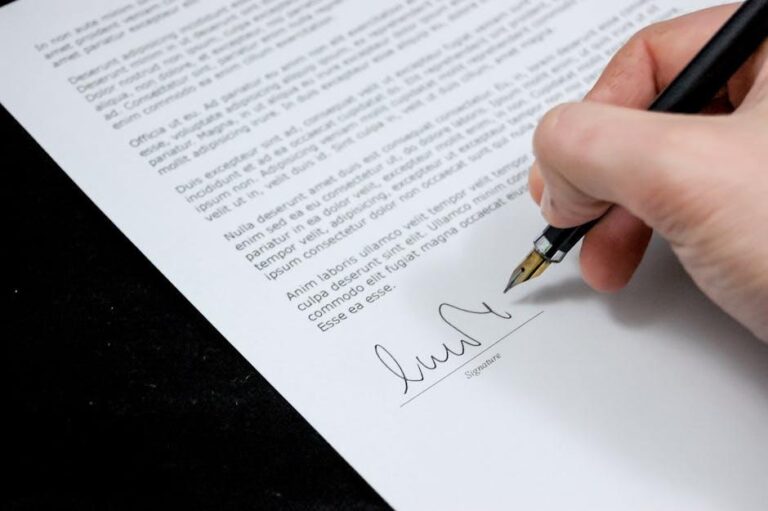Introduction
In the intricate landscape of legal communication, a demand letter serves as a pivotal bridge between informal negotiation and formal litigation. Whether your a business owner seeking to recover unpaid invoices, a tenant advocating for necessary repairs, or an individual asserting a claim against a neighbor, knowing how to craft an effective legal demand letter is essential.This document not only outlines your grievances but also sets the stage for potential resolution without the need for courtroom battles. In this article, we will explore the essential components, strategic considerations, and best practices for writing a compelling demand letter, ensuring your message is clear, professional, and poised for impact. Navigating this process can empower you to advocate for your rights confidently, paving the way for an amicable resolution.
Table of contents
- Understanding the purpose of a Legal Demand Letter
- Essential Elements of a Compelling Demand Letter
- Crafting a Strong Opening: Capturing Attention
- Articulating Your Claims: Presenting Facts and Evidence
- Concluding with Confidence: What to Expect Next
- Best Practices for Sending and Following Up on Your Letter
- Q&A
- To Wrap It up

Understanding the Purpose of a Legal Demand Letter
A legal demand letter serves as a formal request for a specific action or remedy, often used to resolve disputes without escalating the issue to litigation. This writen communication typically outlines the sender’s grievances,the basis for their claim,and the desired resolution. By presenting a clear and concise clarification of the situation, it allows the recipient to understand the seriousness of the matter while providing them an chance to respond constructively. Key components include:
- Clear Statement of Purpose: Explains why the letter is being sent.
- Supporting Evidence: Includes relevant documents or details.
- Deadline for Response: Suggests a timeline for the recipient to act.
The purpose of a demand letter is not merely to express dissatisfaction, but also to open a channel for negotiation. It emphasizes the potential consequences of inaction, which could involve pursuing further legal action. Understanding the components and tone of such correspondence is vital for ensuring that it fulfills its intended function. Below is a simplified overview of the necessary elements:
| Element | Description |
|---|---|
| Sender Information | Name,address,and contact details of the person sending the letter. |
| Recipient Information | name and address of the person receiving the letter. |
| statement of Facts | Brief account of the relevant facts leading to the demand. |
| Demands | Clearly articulated requests for action or remedies. |

Essential Elements of a Compelling Demand Letter
A well-crafted demand letter includes several essential components that enhance its effectiveness. First and foremost, it should contain a clear statement of the purpose, outlining the specific actions you wish the recipient to take. This can include payment of a debt, fulfilling a contractual obligation, or ceasing certain activities.Paired with this, presenting relevant facts and background information helps establish context to your demands, showcasing both your understanding of the situation and establishing credibility. Make sure to include details such as dates, amounts, and other specifics that will lend weight to your claim.
Another crucial element is the inclusion of a deadline for response. By specifying a timeframe for compliance, you create a sense of urgency that encourages action. It’s also advisable to outline the potential consequences of non-compliance, such as escalation to legal proceedings. This acts as a deterrent and emphasizes the seriousness of your request. Consider formatting important points in a list or table to enhance readability and clarity:
| Key Element | Description |
|---|---|
| Purpose Statement | Clearly define what you expect from the recipient. |
| Background Facts | Include relevant details to support your demands. |
| Response Deadline | Set a clear timeframe for the recipient’s action. |
| Consequences | Outline potential next steps if demands are not met. |

Crafting a Strong Opening: Capturing Attention
Beginning your legal demand letter with a compelling opening is crucial. This initial section should establish the context and importance of the issue at hand. You might consider starting with a clear statement of purpose, outlining the specific action you are requesting. As an example:
- Identify the party you are addressing
- Clearly state the nature of the problem
- Articulate the consequences of inaction
Using direct and powerful language can enhance your letter’s impact. It helps to present key information in a way that instantly captures attention and underscores the urgency of your demand. Consider including a brief summary table that highlights the main points you wish to convey:
| Issue | Requested Action | Deadline |
|---|---|---|
| Outstanding Payment | Payment of $1,500 | Within 14 days |
| Contract Breach | Compliance with contract terms | Within 30 days |
This approach not only informs but also invites the reader to act swiftly and decisively, setting a professional tone right from the start.

Articulating Your Claims: presenting Facts and Evidence
To effectively communicate your demands, it’s crucial to base your claims on concrete facts and evidence. Begin by compiling all relevant information that supports your case. This can include:
- Contracts: Any signed agreements that outline the terms and obligations.
- Correspondence: Emails or letters that illustrate the history of communication.
- Invoices: Documents that verify amounts owed or transactions that took place.
- Witness Statements: Testimonies from individuals who can corroborate your claims.
Once you have gathered your evidence, organize it in a clear and structured manner.Present your facts chronologically and ensure they are easy to understand. Use a table to succinctly display essential details, like this:
| Document Type | Description | Date |
|---|---|---|
| Contract | Service Agreement between parties | 2022-01-01 |
| Email Correspondence | Initial demand for payment | 2022-02-10 |
| Invoice | Outstanding balance for services rendered | 2022-03-15 |
This organized approach not only strengthens your argument but also gives the recipient a clear framework to assess your position, making them more likely to respond favorably to your demand.

concluding with Confidence: What to Expect Next
As you finalize your legal demand letter, it’s essential to understand what happens next in the process. Once your letter has been sent, you can expect the recipient to consider their response seriously. Possibilities include direct negotiation, seeking legal counsel, or a refusal to communicate.Regardless of the outcome, it is important to remain prepared for any scenario.Here are a few steps to anticipate:
- Response Timeline: Usually, you can expect a reply within a reasonable time frame, often between 7 to 14 days.
- Negotiation Opportunities: Be open to discussions,as many disputes are resolved before escalating to legal action.
- Document Everything: Keep records of all communications, as these may be crucial if the issue progresses legally.
If the matter does not resolve following your demand, you may need to explore your legal options. It’s wise to consult with an attorney who can assess the situation and advise you on how to proceed. As legal processes can be complex, understanding your rights and the potential for litigation is vital. The following table outlines potential paths you might consider:
| Option | Description |
|---|---|
| Direct Negotiation | Engaging in discussions to reach a mutual agreement. |
| Mediation | Using a neutral third party to facilitate a resolution. |
| Litigation | pursuing formal legal action if no agreement is reached. |

Best Practices for Sending and Following Up on Your Letter
After drafting your legal demand letter, the way you send it is crucial. Consider using certified mail to ensure that you have proof of delivery, which might be essential if the matter escalates.Additionally,you might want to send a copy via email for faster communication,but make sure to request a read receipt. This dual approach can bolster your position should you need to take further action later. Remember to give the recipient a reasonable timeframe to respond, typically 10 to 14 days, to avoid any claims of a rushed confrontation.
Following up is just as important as initial contact. If you haven’t received a response by the deadline, it’s advisable to send a polite reminder reiterating the importance of your initial letter.If there’s still no reply after this, consider documenting your attempts to reach out. Maintaining a timeline of communications can be beneficial if the situation progresses to legal action. Below is a simple table to keep track of your correspondence:
| Date | Method | Details |
|---|---|---|
| MM/DD/YYYY | Certified Mail | Initial Demand Letter Sent |
| MM/DD/YYYY | Follow-Up Reminder sent | |
| MM/DD/YYYY | Phone Call | voice Mail Left |
Q&A
Q&A:
Q1: What exactly is a legal demand letter?
A1: A legal demand letter is a formal document sent to request the fulfillment of a legal obligation, such as payment of a debt, performance of a contract, or resolution of a dispute. It outlines the specifics of the issue, provides evidence or reasoning, and typically includes a timeframe for compliance.
Q2: When should someone consider writing a demand letter?
A2: Consider writing a demand letter when informal attempts to resolve a matter have failed.It’s a strategic way to escalate the issue before pursuing legal action, as it provides a clear record of your intentions and demands.
Q3: Who should receive a demand letter?
A3: A demand letter should be sent to the individual or institution responsible for the issue at hand. This could be a debtor, a business partner, or any party you believe has breached an agreement.
Q4: What are the essential components of a legal demand letter?
A4: A well-crafted demand letter should include the following components:
- your Contact Information: Name, address, and any other relevant details.
- Recipient’s Information: Name and address of the individual or entity.
- Date: When the letter is being sent.
- Statement of the Issue: A clear and concise description of the dispute.
- Supporting evidence: any relevant documents or facts that support your claim.
- Demand for action: What you are asking for and specify a deadline for compliance.
- Consequences of Non-Compliance: Information on what actions you will take if the demand is not met.
- Closing Remarks: A professional sign-off to maintain a tone of formality.
Q5: How should the tone of the letter be structured?
A5: Maintain a professional and neutral tone throughout the letter. While it’s important to be assertive about your demands, avoid language that could be deemed aggressive or threatening.Clear and concise communication is key.
Q6: Is it necessary to consult a lawyer before sending a demand letter?
A6: While it’s not mandatory,consulting a lawyer can be beneficial. They can provide legal advice tailored to your situation, ensure that your letter is legally sound, and help strengthen your case.
Q7: What should I do if I don’t receive a response to my demand letter?
A7: If you don’t receive a response by the deadline specified, you can follow up with a polite reminder. If that fails, you may consider escalating the matter legally, potentially involving a lawyer to explore further actions, such as litigation.
Q8: Can I send a demand letter via email, or should it be a physical letter?
A8: While email can be quicker, sending a physical demand letter via certified mail adds an additional layer of formality and proof of delivery, which is often recommended in legal matters.
Q9: What are common mistakes to avoid when writing a demand letter?
A9: Common pitfalls include being overly emotional or vague, failing to clearly state the timeline for compliance, or neglecting to provide adequate evidence to support your claims. It’s crucial to be concise, precise, and professional.
Q10: Are there any templates available for legal demand letters?
A10: Yes, many templates are available online, but it’s wise to customize them to fit your specific situation. Ensure the language aligns with your case, as using a generic template could lead to miscommunication or misunderstanding.
This Q&A serves as a guide to navigating the intricacies of writing a legal demand letter, ensuring you approach the process with clarity and confidence.
To wrap It up
crafting a legal demand letter is a vital skill that can empower you in various situations, from resolving disputes to asserting your rights. By clearly outlining your position, supporting your claims with relevant evidence, and maintaining a professional tone, you can effectively communicate your intentions while leaving room for resolution. Remember,the ultimate goal is to facilitate dialog and encourage a fair outcome. As you apply these principles,consider each letter an opportunity—not just to demand,but to negotiate and find common ground. Happy writing,and may your words pave the way for justice and understanding.
